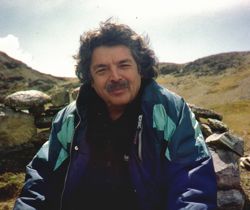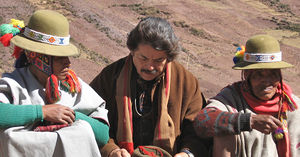Intro: This is the first of many meditations I will be sharing on this blog. I call them ‘meditations’ only because I can’t come up with a better term. In speaking of them I often refer to them as ‘meditative-like processes’, but that is a rather awkward label. I have heard don Americo refer to them as ‘passes’, but that term has never made any sense to me. What they are in essence are ways of working with energy (or spirit). If you haven’t yet, I recommend that you read the post Andean Cosmovision: The Basics and perhaps also the post Paqos: Shamans or Mystics.
About Intent: These meditations involve following some pretty unusual instructions, such as “open your energy at the top of your head and let the energy of the Cosmos flow into your body” (part of a meditation I’ll be sharing in a later post). How do you go about doing something like that? The answer is simple, you do it with intent. Now intent is a pretty interesting thing and worth exploring. To start off with think of intent simply as “sincere pretending”. That’s all. You accomplish the various steps of the meditations by sincerely pretending that you are doing them, that is sufficient to open the door to the experience that becomes possible through the meditation.
Process: This is a very simple, very special meditation. It is one of the two meditations about which I’ve heard Americo say that if we were to just do this one meditation on a regular basis it would have a profound effect on our lives. My ears perk up when I hear something like that.
First, I recommend before all of the meditations that you take a moment before you start to notice how you feel, to get a sense for what your energy is like before you begin, so that you can compare it to how you feel after the meditation.
Here is how to do this meditation. Lay on the ground on your stomach and pull up your shirt far enough so that your bellybutton (navel) is in physical contact with the Pachamama (that great Cosmic Being who is our mother the planet Earth). What you do next depends upon whether you want to get rid of some undesirable energy, or bring the Pachamama’s energy into yourself, or both.
If you have some energy you would like to get rid of (e.g. stress, anger, depression, sorrow, anxiety), then, using your intent (sincere pretending) let that energy flow from you and into the Pachamama. Don’t be concerned about giving this energy to her, it is not like pollution, the Pachamama takes this energy and recycles it into purer energy that is then released into the Cosmos. This is one of her great gifts to us. With your intent, open your energy field around your bellybutton and feel this energy flowing out of your body and into the Pachamama. If you sense that some of it is not leaving–perhaps it feels stuck in some particular part of your body–then you can use your stomach muscles to press your bellybutton to the Pachamama with a few gentle pushes, this can help. You can also, with your intent, request that the Pachamama send her energy into you through your bellybutton to gently draw that energy from you. Do this for as long as it takes to feel that the undesirable energy has left you body. Then you are either finished or you can also go on to the next step.
If you would like some energy from the Pachamama (e.g. tranquility, love, ease, harmony) you can use your intent (sincere pretending) to open your energy field at your bellybutton and invite her to send that energy into you. Another option is to invite her to send her energy into you with the simple intent that she bring your energy into harmony with hers. Getting your energy into harmony with that of the Pachamama is a very beneficial thing for you to do, it helps move us out of all of the weird states our interaction with our social/political world can get us into, and it also helps us stay in harmony with the changes the Cosmos is going through. Bringing in her energy can be facilitated by gently drawing in your stomach muscles a few times, as if pulling her energy into you. Continue until you feel complete.
When you are finished with the meditation take a few moments to notice how you feel now, what your energy is like after the meditation. The difference between how you felt before the meditation and how you feel after it is the true ‘meaning’ of the meditation.
That is the process, and–as is typical of the Andean meditations–it is very simple but the effects (particularly when carried out repeatedly over a long time) can be quite beautiful. Connecting our energy with Nature and the Cosmos is what these meditations are all about. This is the realm of salka, our natural undomesticated energy.
Context: The Andean meditations are the outward form of something deeper, a shift in our relationship with the Cosmos. It is within this relationship that the “magic” of the Andean meditations arise, but this is not how we might normally think of magic for it is not a way to manipulate or harness the powers of Nature. It is instead something that arises within a relationship of love and respect. The context of the Andean meditations, where their benefits arise from and what the meditations help nourish, is a loving and mutually supportive relationship with Nature and the Cosmos. The active principle of this relationship is ayni.
About Ayni: Ayni is the Andean principle of reciprocity, a balancing of giving and receiving which reflects the underlying dynamics of the Cosmos. As you engage in this meditation with the Pachamama, well, I can’t imagine that a deep sense of love and gratitude for the Pachamama won’t arise. To follow the Andean path step into and nourish this relationship, balance your relationship with the Pachamama, give something in love to her in return. Quite simply, with intent, express to her your heart-felt gratitude. Occasionally, as a simple form of ayni, pour a few drops of wine or other alcohol onto the Pachamama with the intent that it honor her and nourish her (and thus give some energy back to her). Remember, this is not a bribe or a payment for services rendered, it is instead like giving flowers unbidden to a loved one. We will be covering more formal and elaborate offerings (called despachos) and taking a deeper look at ayni in later posts.
[Added later] Please see the subsequent post on ayni.
Source of the Meditation: Don Americo Yabar (don Américo Yábar).
Share...


